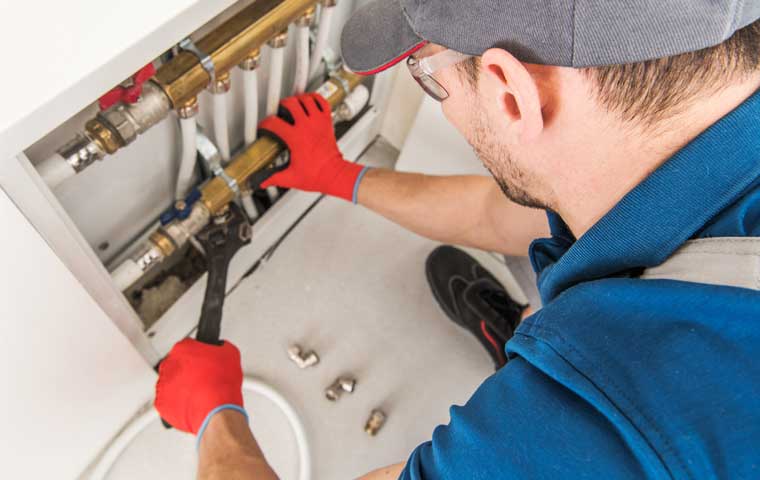Whole House Repiping Services
Regardless of how old your property is or where it is located, even the slightest of negligence may cause water leaks, leading to further plumbing issues. It is especially true if you leave leaks unaddressed. With time, leaks can grow bigger. Eventually, the excess moisture leads to mold, which not only affects the curb appeal of your home but also raises health concerns.
Not to mention, the leaking pipes may cause your water bills to increase while lowering water pressure in the home. So, if you notice it’s taking longer to rinse out conditioner or dishwashing, then the pipes in your home might need attention. Many homeowners have relied on repiping as a way to solve plumbing issues for years.
Fortunately, repipe specialists, such as Conejo Valley Home Services Plumbing & Rooter, can help with whole-house repiping to prevent serious water leakage issues. Keep on reading to learn more about pipe replacement or repiping a house.

Emergency Service
(805) 499-0448
- When Should You Repipe A House?
- What Is Repiping?
- What Is Involved In Repiping A House?
- How Long Does It Take To Repipe A House?
- What To Expect When Repiping A House
- How Much Does It Cost?
- The Best Pipe To Use For Repiping
- Copper Vs PEX
- Benefits To Repiping Your Home
- Save Money By Contacting A Repipe Specialist
When Should You Repipe a House?
Let’s admit, we’ve all faced the occasional leaky pipe or dripping faucet at some point. But if the problem grows severe, whole house repiping or plumbing becomes necessary to fix them. These plumbing issues may vary from corrosion in the existing pipes, lowering water pressure to multiple leaks.
Know that repiping a house is important if the water in the taps comes out rusty. Similarly, if you purchase an older construction, you often need to repipe the whole house before moving into it.
What is Repiping?
Residential pipe replacement refers to a repiping plumbing process. It typically includes installing new piping in the entire house. Professionals replace the pipes with PEX or copper pipes. Sometimes it is a combination of both copper and PEX pipes. The process generally starts by removing the old, rusty piping that’s easy to access. This way, professionals determine the type of piping a home requires.
Once they determine the type of repiping job necessary for the fresh plumbing system, experts decide on a material to repipe the house. They do so by taking factors like climate and budget into account. Keep in mind that the climate of the place you live in is one of the major concerns when it comes to repiping. There are areas where pipes need to be buried as the ground freezes during the winter.
It doesn’t end here, as repiping a house on a slab requires considering many other things for plumbing a structure carefully.
What is Involved in Repiping a House?
When you opt for repiping, remember that it involves several steps as it is a relatively lengthier task compared to other home renovation jobs. Here is a primer of what a residential piping process looks like when you hire professionals such as Conejo Valley Home Services Plumbing & Rooter.
Initial Plumbing Inspection
A qualified repipe specialist visits the house to assess the condition of piping. The professional lets you know if your home requires pipe replacement. You can have a detailed discussion with a specialist about piping options, as well as overall project length and cost. You can also determine your home’s access points.
Scheduling Repiping
Scheduling the entire repiping process wisely is important if you don’t want it to disrupt your routine. It allows plumbing specialists to get the job done quickly without interrupting your family’s activities.
Creating a Safe Workplace
Experts will take preparatory measures to ensure the workplace is secure for the task. It may involve anything from making holes in walls, ceilings, and floors to easily access the pipes. Workers cover the flooring and furniture before drilling to keep your belongings safe.
Installation of New Pipes
The time period for this step varies depending on the type of piping you opt for. If you’re repiping with PEX, it is quicker and easier to install as it is lightweight and flexible. Plus, this type of pipe doesn’t need welding or fittings. However, if piping in your home needs to enter or come out the walls, opt for copper.
There won’t be any long water shut-offs while the process is happening. Usually, old piping continues to work until the new piping is up.
Switching from Old to the New
The step is probably the longest when you repipe a house. It is because it involves a tie-in to connect your main plumbing system to the city water. The repipe specialists need to remove the connection from the old piping system and put it on the new piping.
Cleaning Up
Last but not least, the step involves cleaning up the mess the whole house repiping creates. The workers will repair the holes made in walls, ceilings, and floors. Rest assured that professional plumbing specialists don’t leave you to clean up the mess they made. They remove everything from debris to leftovers of previous piping. A reputable company leaves your house as clean as it was before the process.
How Long Does It Take to Repipe a House?
Repiping for a whole house typically takes two days to seven days, depending on the kind of piping system you need and the home’s size. The process begins with repiping preparations. Most plumbing experts use PEX pipe as it makes the process minimally invasive, thus lowering the risks at the construction site and around the home.
What to Expect When Repiping a House
Replacing your home’s piping is an extensive process. Here’s what you can expect when opting for the process.
Repiping Preparations
As described above, the preparation work for whole house repiping is often pretty straightforward. It begins by inspecting the plumbing system to estimate the piping requirements and cost of the process. A comprehensive estimate explains the type of piping you need to place in the home.
During the Installation
You’ll need to set down tarps for items and flooring that can suffer from damage if the plumbing leaks during the process. The installation process takes a week or two, depending on the plumbing requirements unique to your project. Your plumber can shut off the water supply for a limited time (for a few hours) a day during the installation.
After the Installation
Your repipe specialists will test the pipes before wrapping up the process. They also ensure the ceilings and walls are sealed properly.
How Much Does It Cost?
The average cost to repipe a house has a broad strike zone. We say this because it depends on how much repiping your home needs. Whether you want to redo the whole house or need to replace the connection between the home and the meter, repiping costs could fall between 2 thousand dollars to 10 thousand dollars.
Of course, you have the option to re-line the existing pipes instead of replacing them. If you use trenchless technology, it is far less resource and labor-intensive compared to digging out old pipes. This is a savvy way to reduce repair costs and extend the life of water pipes. Make sure you discuss how much repiping a house costs before the process begins.
Factors Affecting the Cost of Repiping
- Square Footage
- Fixtures Changing
- Fixtures Numbers
- Fixtures Location
- Water Replacement
- Water Main Pipeline
- Repiping Material Type
- How Old a Home Is
The Best Pipe to Use for Repiping
Typically, many homeowners opt for copper pipes as they are popular for their durability. However, if your home is an old construction, it may have galvanized steel pipes. The pipes are long-lasting, so they are prone to springing leaks. Even if the pipes are not old, leaks can indicate that it’s time to replace them.
However, as technology has advanced in the plumbing industry, the newer materials for repiping a house are available in the market. PEX, for instance, is cross-linked polythene that works well for both hot and cold water situations. Compared to copper, repiping with PEX is more flexible and easier when space is narrower.
Let’s compare both the materials to help you make an informed decision.
Copper vs PEX
You need to consider a few things when choosing or picking one pip over the other.
a. PEX Pipes
As mentioned earlier, copper pipes are usually prone to leaks, and these small holes may cause because minerals are present in the ground and the water. Therefore, PEX is a preferable choice. It has fewer joints and doesn’t crack in cold temperatures.
Following are benefits you may get by choosing PEX pipes:
Pros
- PEX repiping is more durable against corrosion and chlorine
- PEX pipes are flexible and easily bend around the corners, unlike copper pipes that need fitting to fit properly
- PEX pipes don’t make running water sound obvious through pipes
- Attaching PEX pipes to the existing copper structure is possible. If replacing everything at once is unaffordable, repiping with PEX is an ideal option.
- Shipping PEX pipes are cheaper as they are lighter and come in larger spools.
- PEX helps conserve energy.
- PEX material doesn’t heat up like copper piping
Cons
- PEX is not appropriate for outdoor installation
- PEX pipes are not recyclable.
- Water damage may occur as the material isn’t impassable
b. Copper
While many homeowners think PEX piping is the way to go, they are not suitable for all areas. Copper, in this regard, is the oldest option for repiping. It is long-lasting and can be used outside the home structure.
Following are benefits you may get by choosing the copper pipes:
Pros
- You can purchase copper pipes in soft and rigid forms. Plumbers trust copper for durability.
- Repiping with copper is great for the tap water system and HVAC.
- Soft copper is ideal for heat pumps and air conditioners
- You can use rigid copper pipes for water lines as they stand heat better than PEX
- Recycling copper is possible, which makes it an eco-friendly option
- Copper comes color-coded. Red is for hot and blue is for cold
- Fitting that copper pipes use is almost leak-proof
- Copper doesn’t make toxic gasses if the home catches fire
- Copper is excellent for pipes to run outside of the house because the UV rays don’t affect it
Cons
- Copper corrodes over time
- Extreme cold causes the pipes to burst
- Copper is a more expensive option than PEX
Since you know the positive sides of PEX and copper piping, you can make the choice that fits your home’s plumbing needs the most.
Benefits to Repiping Your Home
Still unsure why you should choose the whole house repiping? Check out these benefits of installing new pipes in the house.
Upgrades Plumbing System
By far, you have learned that pipes do not last forever. If you live in a region with harsh climate conditions or your home is just old, they may begin to wear off after a few years. Repiping is an excellent solution to improve water quality and prevent past plumbing problems.
Fixes Cold Issues and Water Pressure
A variety of factors may affect water pressure in a home. These include issues with the main water supply, multiple water sources in one house, and leaking pipes. If pipes in your home are corroding, it can also lead to water pressure issues. The best way to prevent this from occurring is pipe replacement.
Protects Against Water Damage
Don’t wait for things to go wrong to change the piping in your home. Repiping a house before an emergency plumbing issue arises is an ideal way to protect your home from water damage.
Save Money by Contacting a Repipe Specialist
Conejo Valley Home Services Plumbing & Rooter is a repiping specialist specializing in residential pipe replacement. We work with a large crew and trained teams to repipe homes within days. As repiping is our forte, we offer reasonable and fair prices.
Our experts can provide appropriate repiping options after conducting an in-depth analysis of your plumbing conditions. They will guide and explain to you the entire process to help you save money and get the best job done in time.
Whether you’re considering repiping with PEX or copper, call us to schedule a visit and get a FREE estimate for your pipe replacement.
Our innovative solution
- Water Heaters
- Drain Cleaning
- Re-Pipe Specialists
- Sewer Inspection

Why choose Conejo Valley Home Services Plumbing & Rooter?
-
Trusted, certified technicians
-
Emergency Repairs
-
Available 24/7
-
Exceptional Service Guarantee
-
Locally Owned and Operated
-
Licensed and Insured
-
Workmanship Parts Guaranteed
-
Courteous, Uniformed Professionals
-
Convenient Appointment Times
Why Choose Our
Plumbing & Rooter Services?
free estimates
Schedule a free estimate of your home’s plumbing system to spot or identify leaks, cracks, and hidden issues.24/7 emergency service
We stay connected to our clients 24/7. We value your time and offer help no matter when or where you need it.Licensed, Insured, Bonded
We are a team of bonded, insured, and certified contractors to protect you from unforeseen damages and costs.Need a Plumbing Service?
To get in touch with us fill out our contact form below.
or call our team at (805) 499-0448 today!















